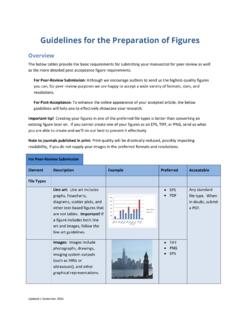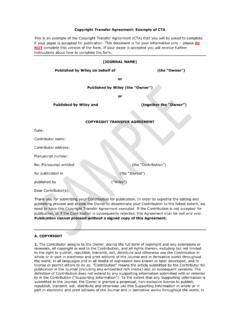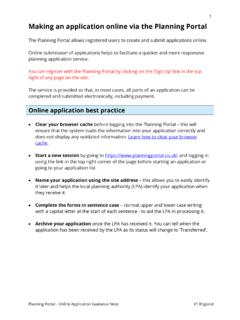Transcription of Best Practice Guidelines on Publishing Ethics
1 Best Practice Guidelines on Publishing Ethics A Publisher s Perspective Second edition 2014 John Wiley & Sons, Ltd. CC BY-NC Contentsintroduction 1 Aims and scope 1 committee on Publication Ethics (coPe) 1 Ethics Helpdesk at Wiley 1 First: Speak with your publisher 2 Research integrity 2 Misconduct 2 Whistle blowing 2 Fabrication, falsification.
2 And image manipulation 3 Plagiarism 3 duplicate and redundant publication 3 Sanctions 4 Research Ethics in journal articles 5 Human rights, privacy, and confidentiality 5 cultures and heritage 5 Registering clinical trials 6 Animals in research 6 Biosecurity 7 Reporting Guidelines 7editorial standards and processes 7 Authorship 7 Authorship disputes
3 9 Funding 9 Peer review 9 timing of publication 10 editors and journal staff as authors 10 conflicts of interest 10 Libel and defamation 11 editorial independence and commercial issues 11 Academic debate 12 Appeals 12 corrections 12 Retractions and expressions of concern 13 Withdrawal of articles 13 data protection legislation 13copyright and intellectual property 13 Resources for responsible publication policies and procedures 15 Flowcharts 21 Sample letters 39contributors 53intRoductionIf you are
4 Reading a printed version of this document, you will not have access to embedded urls as reference points. To access these, please visit the HTML version of the document online at and scopethese Guidelines present a comprehensive update to the Wiley publication Ethics Guidelines first published in 2006. our aim for these Guidelines remains to support all those involved in scholarly Publishing with a summary of best Practice guidance from leading organizations around the world. our Guidelines are written for societies, editors, authors, librarians, students, funders, corporations, and write this new edition, we recruited contributions from a multidisciplinary and regionally diverse group of experts within and outside Wiley.
5 We hope that our multidisciplinary approach has made these Guidelines unique and useful to many. We recognize that different disciplines have different practices and traditions and that one size does not necessarily fit all. Where Guidelines have particular application to one discipline or group of disciplines, we have aimed to identify this clearly in the on Publication Ethics (COPE)Wiley provides membership of the Committee on Publication Ethics (COPE) as an option for all of its journal editors. At the time of writing coPe serves more than 8500 members around the world with practical tools, e-learning, seminars, and much more. Many editors and publishers find coPe s tools indispensable.
6 We have listed specific coPe tools amongst the many Ethics resources that are available to editors wherever relevant throughout our Guidelines . We have reproduced the coPe flowcharts and sample letters with permission from coPe in full in the print version of these Guidelines . coPe has published two codes of conduct, one for publishers and one for editors: Code of Conduct for Editors Code of Conduct for Publishers Ethics Helpdesk at Wileyif you are a Wiley editor or author looking for help then please make your first port of call your Wiley publisher or journal Publishing manager. otherwise, and if your query relates to matters addressed by or related to these Guidelines , please contact the Wiley Ethics Helpdesk.
7 The Helpdesk is an email address from which we direct incoming queries to the person at Wiley who has the most appropriate expertise: Best Practice Guidelines on Publishing Ethics WiLeY / BeSt Practice Guidelines on Publishing Ethics PAGe 1 First: Speak with your publisherJournal Publishing is, at its best, a team effort. Handling ethical problems relating to journals is no exception, and publication Ethics issues often give rise to or involve legal issues. We suggest that journals use these Guidelines to establish clear policies and procedures, and as an initial point of reference when issues a first step to addressing any potentially serious problem we suggest that editors, publishers, and other journal team members discuss the issues they are facing.
8 We suggest that these discussions happen before taking any further action, and that legal advice is sought where needed and in particular where issues involve potential defamation, breach of contract, or copyright conversations may indicate the need to carry out further investigation or to widen discussions to: Involve relevant institutions, employers, or funders (which are the appropriate bodies to conduct most investigations of serious misconduct). Consult with other journal editors who are involved (in cases where coordinated efforts may be useful, being mindful of sensitivities around confidentiality). Seek advice from other editors via a COPE Forum (coPe maintains a record of cases discussed at the coPe Forum since 1997).
9 Research integrityMisconduct Research misconduct is defined in the US Federal Policy on Research Misconduct: Research misconduct is defined as fabrication, falsification, or plagiarism in proposing, performing, or reviewing research, or in reporting research results. the international models for responding to misconduct are discussed by the council of Science editors in their recommendations for identification of misconduct and Guidelines for action. the World Association of Medical editors makes suggestions about responding to allegations of misconduct. The Singapore Statement on Research Integrity, written during the Second World congress on Research integrity, presents principles and professional responsibilities that are fundamental to the integrity of research wherever it is undertaken.
10 Members of journal Publishing teams have an important role to play in addressing potential cases of data fabrication, falsification, plagiarism, image manipulation, unethical research, biased reporting, authorship abuse, redundant or duplicate publication, and undeclared conflicts of interest. in most instances journals should request investigations by research institutions, employers, funders, or the relevant national statutory body (for example, the Austrian Agency for Research Integrity) rather than conducting investigations themselves. However, it can be appropriate for some cases of misconduct (for example, plagiarism or image manipulation) to be investigated and acted upon by a journal Publishing team, but even then the journal Publishing team should inform the relevant parties.









